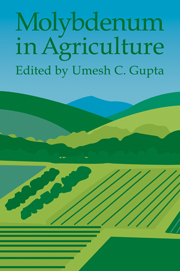Book contents
- Frontmatter
- Contents
- List of contributors
- Preface
- 1 Introduction
- 2 Chemistry and Mineralogy of Molybdenum in Soils
- 3 Distribution and Mobility of Molybdenum in the Terrestrial Environment
- 4 Biochemical Significance of Molybdenum in Crop Plants
- 5 Soil and Plant Factors Affecting Molybdenum Uptake by Plants
- 6 Analytical Techniques for Molybdenum Determination in Plants and Soils
- 7 Testing for Molybdenum Availability in Soils
- 8 Molybdenum Availability in Alkaline Soils
- 9 Deficient, Sufficient, and Toxic Concentrations of Molybdenum in Crops
- 10 Symptoms of Molybdenum Deficiency and Toxicity in Crops
- 11 Sources and Methods for Molybdenum Fertilization of Crops
- 12 Yield Responses to Molybdenum by Field and Horticultural Crops
- 13 Responses of Forage Legumes and Grasses to Molybdenum
- 14 Molybdenum and Sulfur Relationships in Plants
- 15 Molybdenum in the Tropics
- Index
11 - Sources and Methods for Molybdenum Fertilization of Crops
Published online by Cambridge University Press: 10 December 2009
- Frontmatter
- Contents
- List of contributors
- Preface
- 1 Introduction
- 2 Chemistry and Mineralogy of Molybdenum in Soils
- 3 Distribution and Mobility of Molybdenum in the Terrestrial Environment
- 4 Biochemical Significance of Molybdenum in Crop Plants
- 5 Soil and Plant Factors Affecting Molybdenum Uptake by Plants
- 6 Analytical Techniques for Molybdenum Determination in Plants and Soils
- 7 Testing for Molybdenum Availability in Soils
- 8 Molybdenum Availability in Alkaline Soils
- 9 Deficient, Sufficient, and Toxic Concentrations of Molybdenum in Crops
- 10 Symptoms of Molybdenum Deficiency and Toxicity in Crops
- 11 Sources and Methods for Molybdenum Fertilization of Crops
- 12 Yield Responses to Molybdenum by Field and Horticultural Crops
- 13 Responses of Forage Legumes and Grasses to Molybdenum
- 14 Molybdenum and Sulfur Relationships in Plants
- 15 Molybdenum in the Tropics
- Index
Summary
Introduction
Molybdenum (Mo) deficiencies have been reported from many countries around the world, mainly in acidic soils. Sandy soils are Mo-deficient more often than are loam or clay soils. Most Mo deficiencies are associated with legume crops, because Mo is an essential constituent of enzymes necessary for fixation of nitrogen (N) by bacteria growing symbiotically with legumes. Molybdenum is also required in other enzyme systems in all plants.
The availability of Mo in soil increases with increasing soil pH. Therefore, liming a soil to the recommended pH range may increase the plant availability of soil Mo sufficiently that Mo fertilization may not be required. This chapter discusses the sources of Mo and the methods of applying Mo fertilizers to those crops that require additional Mo to produce optimum crop yields.
Molybdenum Sources
There are fewer sources of Mo for fertilizers than there are for the other micronutrients (Table 11.1). Ammonium and sodium molybdates and molybdic acid are soluble compounds. These sources of Mo are sometimes applied with other fertilizers or are used as foliar sprays. Both MoO3 a nd Mo frits are insoluble in water, but are effective if applied as fine powders; MoO3 is applied as a seed coating in many cases.
Municipal sewage sludges and fly-ash materials, both waste products, contain Mo that is available to crops. Because these two materials are applied to soils at relatively high rates (5–401 tha–1), their Mo contents should be considered when determining their application rates.
- Type
- Chapter
- Information
- Molybdenum in Agriculture , pp. 171 - 181Publisher: Cambridge University PressPrint publication year: 1997
- 3
- Cited by



